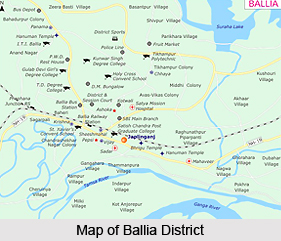 Ballia District is in the easternmost part of Uttar Pradesh. The district lies between the parallels of 25 degree 33 minutes and 26 degree 11 minutes north latitudes and 83 degree 38 minutes and 84 degree 39 minutes east longitudes. Ballia District is bounded on the west by Azamgarh, on the north by Deoria, on the north-east and south-east by Bihar and on the south-west by Ghazipur. Total area covered by this district is around 3168 sq kms and it is in the 51st position in terms of area in the state.
Ballia District is in the easternmost part of Uttar Pradesh. The district lies between the parallels of 25 degree 33 minutes and 26 degree 11 minutes north latitudes and 83 degree 38 minutes and 84 degree 39 minutes east longitudes. Ballia District is bounded on the west by Azamgarh, on the north by Deoria, on the north-east and south-east by Bihar and on the south-west by Ghazipur. Total area covered by this district is around 3168 sq kms and it is in the 51st position in terms of area in the state.
History of Ballia District
The origin of the name of Ballia District has long been a matter of dispute. It is locally said to have been derived from the name of Indian sage Valmiki, author of Ramayana, who resided here. Another belief about the origin of the name is that it has been derived from the sandy nature of the land of the place, locally known as `ballua` (balu meaning sand). Ballia District was a part of Indus Valley Civilization.
Geography of Ballia District
Geography of Ballia District comprises an irregularly shaped tract extending westward from the confluence of Ganga River and Ghaghara River, the former separating it from Bihar in the south and the latter from Deoria and Bihar in the north and east respectively. The boundary between Ballia and Bihar is determined by the deep streams of these two rivers. Climate of Ballia District is hot and humid in nature. On individual days the maximum temperature may reach over 47 degree Celsius. With the onset of the monsoon in the district by about the middle of June, there is an appreciable drop in day temperatures but nights continue to be as warm as during the latter part of the summer. After the monsoon season early in October, temperatures begin to decrease, the drop being more rapid after October. January is usually the coldest month with the mean daily maximum, temperature dropping to 23.9 degree Celsius. The district is not very rich in mineral resources. Not being endowed with vast forests, the variety and number of wild animals is limited in the district. Fox and jackal are commonly found. Wide pig is found in the lowlands of the Ganga and Ghaghara and black buck in the patches of trees found along the banks of the Ganga, particularly in Pargana Doaba. A variety of birds is found in the district.
Ballia District has contributed immensely to Hindi Literature and Ballia, the district headquarters, is also called as a holy city as it has several temples.






